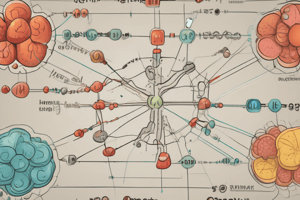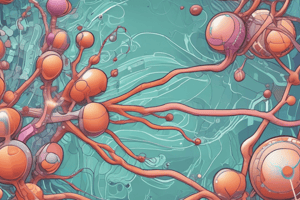Podcast
Questions and Answers
What is the rationale behind the conversion of fructose 6-phosphate to fructose 1,6-bisphosphate?
What is the rationale behind the conversion of fructose 6-phosphate to fructose 1,6-bisphosphate?
- Generation of a high-energy phosphate compound (correct)
- Priming phosphorylation to facilitate symmetrical cleavage
- Activation of fructose for energy production
- Preparation for the formation of glyceraldehyde-3-phosphate
What is the purpose of the oxidation of glyceraldehyde 3-phosphate to 1,3-bisphosphoglycerate?
What is the purpose of the oxidation of glyceraldehyde 3-phosphate to 1,3-bisphosphoglycerate?
- Conversion of a high-energy compound to a low-energy state
- Generation of NADH
- Incorporation of inorganic phosphate
- Formation of a high-energy phosphate compound (correct)
Why is it important to keep the concentration of glyceraldehyde-3-phosphate low during the triose phosphate interconversion?
Why is it important to keep the concentration of glyceraldehyde-3-phosphate low during the triose phosphate interconversion?
- To slow down the glycolysis process
- To ensure proper substrate availability for the next enzyme (correct)
- To maintain a high NADH/NAD+ ratio
- To prevent the formation of high-energy compounds
What is the primary purpose of the migration of phosphate in the glycolysis pathway?
What is the primary purpose of the migration of phosphate in the glycolysis pathway?
Which process uses the energy of ATP and is an irreversible reaction in glycolysis?
Which process uses the energy of ATP and is an irreversible reaction in glycolysis?
What is the significance of the dehydration of 2-PG to PEP in glycolysis?
What is the significance of the dehydration of 2-PG to PEP in glycolysis?
Which enzyme is highly regulated in glycolysis by ATP, fructose-2,6-bisphosphate, and other metabolites?
Which enzyme is highly regulated in glycolysis by ATP, fructose-2,6-bisphosphate, and other metabolites?
What is the net production of ATP per glucose molecule in glycolysis?
What is the net production of ATP per glucose molecule in glycolysis?
Which compound is committed to become pyruvate and yield energy in glycolysis?
Which compound is committed to become pyruvate and yield energy in glycolysis?
What are the inhibitors of glyceraldehyde-3-phosphate dehydrogenase in glycolysis?
What are the inhibitors of glyceraldehyde-3-phosphate dehydrogenase in glycolysis?
What are the transport mechanisms for glucose to enter cells?
What are the transport mechanisms for glucose to enter cells?
What is the primary purpose of aldose-ketose isomerization in glycolysis?
What is the primary purpose of aldose-ketose isomerization in glycolysis?
What is the purpose of glycolysis?
What is the purpose of glycolysis?
In which cellular compartment does glycolysis take place?
In which cellular compartment does glycolysis take place?
Under anaerobic conditions, what can pyruvate be converted to?
Under anaerobic conditions, what can pyruvate be converted to?
What is the main source of metabolic energy in some mammalian tissues and cell types?
What is the main source of metabolic energy in some mammalian tissues and cell types?
What is the purpose of the Pentose Phosphate Pathway in glucose metabolism?
What is the purpose of the Pentose Phosphate Pathway in glucose metabolism?
What is the main difference between glycolysis under anaerobic and aerobic conditions?
What is the main difference between glycolysis under anaerobic and aerobic conditions?
What is the significance of glucose utilization storage?
What is the significance of glucose utilization storage?
What is the overall outcome of glycolysis?
What is the overall outcome of glycolysis?
What is the primary function of the preparatory phase in glycolysis?
What is the primary function of the preparatory phase in glycolysis?
Which tissues can meet their energy needs on glucose only?
Which tissues can meet their energy needs on glucose only?
What is the main difference between alcoholic fermentation and lactic acid fermentation?
What is the main difference between alcoholic fermentation and lactic acid fermentation?
What is the function of the Pentose Phosphate Pathway in addition to generating NADPH for reductive biosynthetic processes?
What is the function of the Pentose Phosphate Pathway in addition to generating NADPH for reductive biosynthetic processes?
What is the primary source of metabolic energy in some mammalian tissues and cell types?
What is the primary source of metabolic energy in some mammalian tissues and cell types?
What inhibits pyruvate kinase (PK) activity?
What inhibits pyruvate kinase (PK) activity?
What is the effect of an increase in fructose 6-phosphate ([F6P]) on glucokinase activity?
What is the effect of an increase in fructose 6-phosphate ([F6P]) on glucokinase activity?
What regulates the phosphofructokinase (PFK) activity in liver cells?
What regulates the phosphofructokinase (PFK) activity in liver cells?
What is the impact of high levels of ATP on phosphofructokinase (PFK) activity?
What is the impact of high levels of ATP on phosphofructokinase (PFK) activity?
What is the role of fructose 2,6-bisphosphate (F-2,6-BP) in regulating PFK activity?
What is the role of fructose 2,6-bisphosphate (F-2,6-BP) in regulating PFK activity?
How does phosphofructokinase (PFK) respond to a decrease in pH in muscle cells?
How does phosphofructokinase (PFK) respond to a decrease in pH in muscle cells?
What is the impact of high levels of glucose on glucokinase activity?
What is the impact of high levels of glucose on glucokinase activity?
What indirectly stimulates the synthesis of fructose 2,6-bisphosphate (F-2,6-BP)?
What indirectly stimulates the synthesis of fructose 2,6-bisphosphate (F-2,6-BP)?
What regulates the activity of glucokinase in the liver?
What regulates the activity of glucokinase in the liver?
How does glucokinase respond to an increase in glucose levels?
How does glucokinase respond to an increase in glucose levels?
Flashcards are hidden until you start studying




